- Who Controls the FCC?
- Report: ACP Pays for Itself
- BEAD Funding Dispute
- Bill Addresses Broadband Transparency, Barriers
- $26 Million Grant Supports Connectivity in New York
- Report Offers Road Map for Digital Inclusion
WHO CONTROLS THE FCC?
A new executive order (EO) Tuesday from President Donald Trump calls for presidential oversight on independent federal agencies, including the FCC.
The FCC is an independent federal agency monitored by elected officials, charged with the implementation and enforcement of national communications law and regulations. It has operated as an independent federal agency since its creation in 1934.
The EO fact sheet criticizes the ability of such agencies to issue rules and spend tax dollars without presidential consultation, stating that independent agencies will no longer “impose rules on the American people without oversight or accountability.”
However, the FCC is overseen by Congress and is led by five commissioners that are selected by the president and confirmed by the U.S. Senate. In November, Trump appointed Brendan Carr to serve as FCC chairman.
In a statement from the Center for Democracy and Technology (CDT), the organization criticizes the executive order for contradicting the U.S. Constitution and U.S. law. In its statement, CDT argues that the purpose of having independent agencies at the federal level is for them to operate as experts on specific topics without subjection to politics.
“For a century, these agencies have been independent for a reason — Congress needs these experts to interpret the laws it passes, and to initiate investigations and enforce those laws without political favoritism,” CDT president and CEO Alexandra Reeve Givens said in a statement. “Our system of checks and balances is quickly crumbling under this Administration.”
The FCC is typically split along party lines, and after his appointment, Carr made a statement in which he committed to stop work on “any partisan or controversial matter and focus on the transition.”
However, since then, Carr ended the agency’s inclusion of diversity and equity in its strategic plan, budget and action plan — a move criticized by Commissioner Anna M. Gomez for defying direction from Congress. Carr has also launched an investigation into the practices of private-sector companies.
REPORT: ACP PAYS FOR ITSELF
The Affordable Connectivity Program (ACP) more than paid for itself, according to a new study from the Brattle Group.
The program ended in 2024 due to a lack of funding — in spite of the introduction of legislation that would have sustained funding and abundant support from advocates including the Biden-Harris administration, a coalition of governors, a group of senators and a variety of other organizations.
According to the new report, the total quantified benefits in the areas of health care, education and the labor market are significantly greater than the program’s annual cost of $7.3 billion, and reinstating the ACP could be a boon for the economic and health-care sectors.
“The ACP delivers exceptional returns on investment,” said the report. “For the reasons stated in this paper, reinstating the program would yield substantial economic and social benefits far outweighing its fiscal cost.”
BEAD FUNDING DISPUTE
Questions remain around the future of the Broadband Equity, Access, and Deployment (BEAD) program as partisan criticisms slow its progress.
AJan. 20 executive order from President Donald Trump called for a pause on Bipartisan Infrastructure Law funding. After that, a U.S. district judge’s ruling subjected Trump’s proposed policyto two temporary restraining orders for illegally attempting to seize the power to make funding decisions from Congress.
The Advanced Communications Law and Policy Institute (ACLP) last week released a report, How to Free BEAD From its Bureaucratic Shackles. The report offers recommendations for members of the federal government, including the president and National Telecommunications and Information Administration (NTIA) administrator nominee Arielle Roth.
Recommendations include rolling back environmental rules attached to BEAD grants, allowing states to adjust the size of areas where funding will be deployed, and eliminating burdensome requirements added by states.
In a statement, ACLP Director Michael Santorelli criticized the program for not having built any BEAD-funded networks yet. However, BEAD Program Director Evan Feinman previously emphasized to Government Technology that the program’s 10-year timeline was written into law by Congress.
Notably, Feinman explained that the BEAD program is structured differently from related federal programs as it is designed to be state-led with the goal of achieving universal coverage. He noted that states like Louisiana and Nevada are expected to have shovels in the ground prior to other states.
The ACLP announcement claims BEAD funds have been “shackled by bureaucracy” under former President Joe Biden. However, Trump’s Jan. 20 EO “Unleashing American Energy” called for a pause in Bipartisan Infrastructure Law funding, which has since been subjected to temporary restraining orders by a U.S. district judge. As of Thursday morning, no BEAD announcements have been made by NTIA since the EO was issued.
Demand for the program remains strong. Washington state recently announced that 307 applications were submitted for its first round of BEAD funding.
BILL ADDRESSES BROADBAND TRANSPARENCY, BARRIERS
The Federal Broadband Deployment Tracking Act was reintroduced last week in the U.S. House of Representatives. The legislation calls on NTIA to submit a plan to Congress within 180 days detailing how it will track the progress of broadband permitting applications on federal lands. The bill would also require NTIA to detail and implement plans for addressing potential barriers.
The legislation had been introduced previously, and passed unanimously in the house in December. Rep. August Pfluger has said this legislation could accelerate the speed with which broadband projects are completed.
NTIA has been charged with overseeing distribution of the $42.5 billion BEAD program, and because permitting applications on federal lands have created a barrier, the program could be impacted.
$26 MILLION GRANT SUPPORTS CONNECTIVITY IN NY
In state news, New York Gov. Kathy Hochul has announced a $26 million ConnectALL grant for Oswego County. This program is funded federally through the Treasury Department's Capital Projects Fund under the American Rescue Plan Act.
“Expanding reliable broadband connectivity is crucial for New York State's economic growth,” Hope Knight, Empire State Development president, CEO and commissioner, said in a statement.
The grant will support the construction of a fiber-to-the-home network, expanding broadband access to more than 10,000 locations with the construction of 345 miles of fiber infrastructure. The money is part of the state’s Municipal Infrastructure Program.
ROAD MAP FOR DIGITAL INCLUSION
The Urban Institute, a nonprofit research organization using data to support upward mobility and equity, has released a new report, Expanding Digital Opportunity: A Framework and Road Map for Strengthening Digital Inclusion.
The document reveals the digital divide disproportionately affects some populations. It argues the populations that would benefit from digital inclusion investments and resources include people of color, tribal communities, people with lower incomes, women, people living in rural areas, older adults, justice-impacted populations, many people with disabilities, people experiencing homelessness, and immigrant and refugee populations.
The report recommends solutions like place-based subsidies, subscription subsidies, device access, technical support and digital skills training. It also recommends that future research be more inclusive of marginalized populations.









